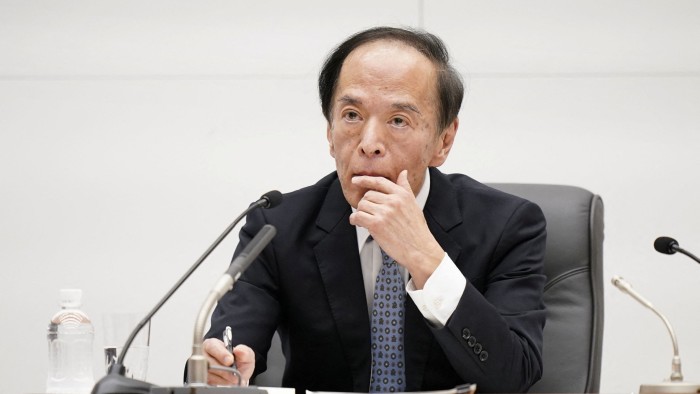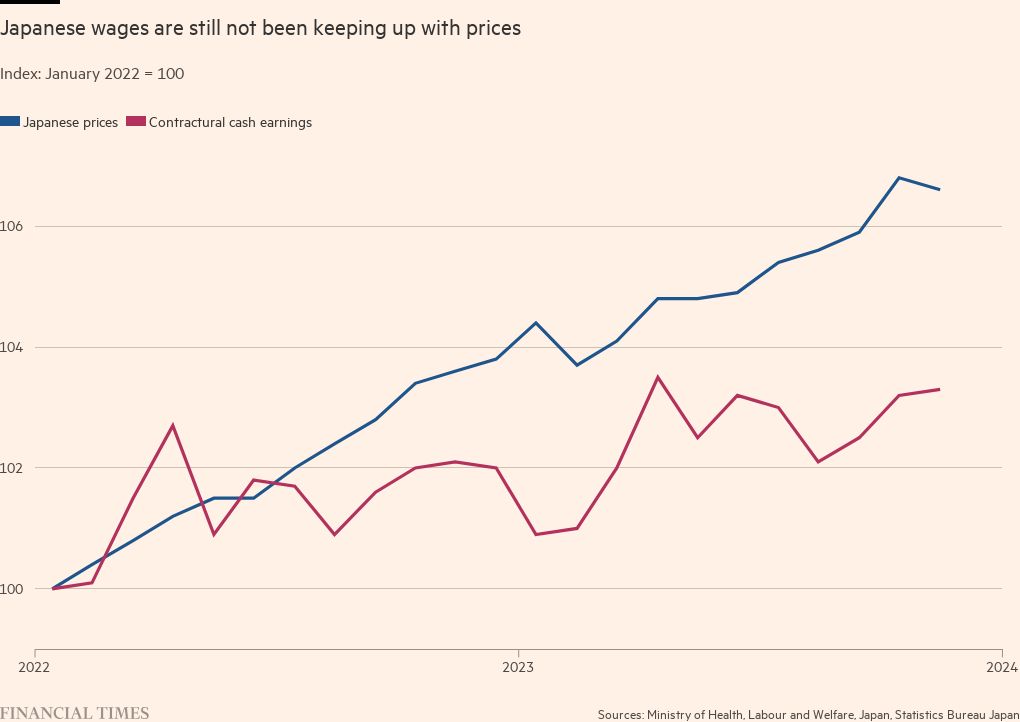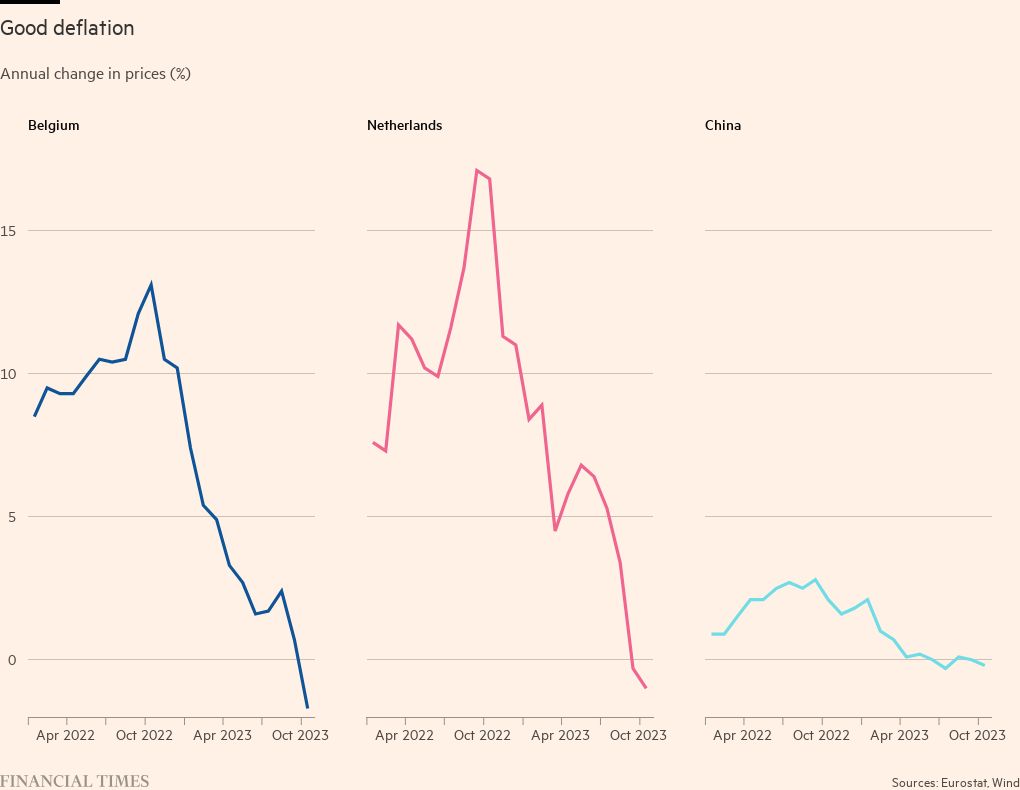Japan’s elusive wage-price spiral

Roula Khalaf, Editor of the FT, selects her favourite stories in this weekly newsletter.
This article is an on-site version of our Chris Giles on Central Banks newsletter. Sign up here to get the newsletter sent straight to your inbox every Tuesday
Hello. This week I will be looking at some exceptions to normal economic rules: specifically that wage-price spirals can be good and deflation isn’t always bad. The main piece will study Japan, an economy we also so often cast aside as an outlier, as I did last week. There is now the tantalising prospect that it might soon lose its special case status, but it is too early to be confident.
What are your favourite examples of deviations from normal economics? Email me at chris.giles@ft.com.
Japan turning European?
Let’s first recap. Japan’s property and stock market bubble burst at the start of the 1990s, leaving the economy with persistently low growth, rock-bottom interest rates and periods of deflation. It is wrong to see the 30-year period thereafter as a uniform period. Instead, it was split into distinct but reinforcing chapters: a 1990s financial crisis, mild deflation in the 2000s and a battle to prevent a declining workforce through the 2010s, due to an ageing population.
As the chart below shows, although Japan wanted low and stable inflation — 2 per cent a year — prices at the start of 2013 were exactly the same as they were 20 years earlier. Even with a bit of inflation thereafter, they were only 6 per cent higher at the start of 2022 than in 1993. With such low inflation and a persistently weak economy, Japan’s monetary policy led the world in being extraordinarily loose. Starting in 1999, the Bank of Japan pioneered zero interest rates, then quantitative easing, negative interest rates, quantitative and qualitative easing and yield curve control in repeated aggressive efforts to bring down longer-term borrowing costs. But low inflation ended last year when it took off for the first time since the bubble burst in 1990, with prices rising 6 per cent in less than two years.
The reasons for Japan’s rise in prices are pretty clear. The nation could not avoid the supply chain difficulties and energy price rises that raised the prices of goods globally. And those initial rises in food, goods and energy costs have spread into core inflation, with the latest national inflation rate at 3 per cent in September and core inflation, excluding fresh food and energy, at 4.2 per cent. Japan has not had a core inflation rate starting with a four since 1981.
So, are Japan’s deflationary problems over?
The best person to answer is BoJ governor Kazuo Ueda, and Martin Wolf asked him just this question at the FT’s Global Boardroom virtual conference last week. Ueda was careful and said that while deflation threats were not in the past, the nation was nearly at a point when it could say it had sustainably raised inflation close to the 2 per cent a year level.
Why the caution?
Ueda explained that there were two drivers of higher inflation in Japan. The first was higher prices for imports which were passing through to domestic prices. These were partly caused by the 25 per cent fall in the value of the Japanese yen since 2020 on a trade-weighted basis as shown in the chart below. This effect was “waning”, Ueda said.
The second effect was a welcome wage-price spiral, he added. Calling for higher wage growth to keep prices rises sustainably at 2 per cent a year, Ueda said, “we would like to see a spillover of wages to domestic prices”. Unlike other central bankers who do not wish for high inflation to become embedded in wages, this is exactly what the BoJ wants to begin to make Japan’s macroeconomics more normal.
Ueda said there was “still some distance to cover” before he could be sure that the modest wage-price spiral would endure, and he was watching the spring 2024 wage round with keen interest. The BoJ has revised higher its expectation of inflation for the 2025 fiscal year to 1.7 per cent, up from 1.6 per cent in its July forecasts, showing it is inching towards the point when it can say it has durably solved its low inflation problem. In the summer of 2022, the BoJ thought it was only on track to increasing longer-term inflation to 1.1 per cent.
Things might even be a little brighter because after the monetary policy meeting, demand in Japan’s economy received a potentially helpful shove via the government’s new stimulus package. Views differ, however, on both the effectiveness of this stimulus and its desirability (with a trenchant FT editorial saying it was poorly timed).
Where does Japanese policy go from here?
So long as the economy holds up in the months ahead, everything depends on the spring wage round. Japan’s powerful Keidanren business lobby last week signalled an intention for its members to seek pay increases of 4 per cent, matching a similar effort this year.
If Japan gets its wage-price spiral, we can expect the BoJ to move from its gradual relaxation of yield curve control towards raising interest rates from the current negative level of minus 0.1 per cent. Ueda made it clear that doing this safely after so many years posed “a serious challenge”. We should not expect an aggressive BoJ, in my view.
It could also do next to nothing to tighten policy — something like a purely symbolic rise in rates to 0 per cent. But as the chart below shows, big ambitions for pay increases by the largest companies are often not translated into wage gains for all employees, particularly in smaller companies. Worse, pay levels have not been keeping up with inflation, so it’s not correct to say that Japan has achieved its desired wage-price spiral yet.
As Ueda told the FT, the bigger risk is still that Japan does not escape its 30-year low inflation trap. The governor said that if inflation overshoots, he could raise interest rates, but if it undershoots, “it is rather difficult to deal with it”.
That is something all seven BoJ governors since 1990 have known.
A chart that matters — good deflation
Deflation is bad, right? Normally, yes, because falling prices make it more difficult for companies to service debts, which do not fall in value. When associated with falling wages, household borrowing also becomes more difficult to finance, leading to the possibility of a vicious circle of rising real levels of debt, default and further drops in wages and prices.
But when overall prices fall because we become more efficient in production, supply costs fall or import prices drop — deflation is great. Things get cheaper; we get richer. So, China’s slide into deflation of 0.2 per cent in the year to October, caused by a 30 per cent decline in pork prices is really nothing to get too exercised about, unless you are a pork producer hoping for juicy returns. In fact, it is literally a hog cycle in which a lot of piglets were reared when prices were high, causing an oversupply and falling prices. Deflation in the Netherlands and Belgium in October were similarly caused by falling energy prices and a positive boon for their citizens. Rejoice.
Let me know if you disagree at chris.giles@ft.com.
What I’ve been reading and watching
Highlighting the communications difficulties I outlined last week, Federal Reserve chair Jay Powell sought to dampen expectations of a relatively quick US rate cut, as did European Central Bank president Christine Lagarde when she spoke to the FT. For those wanting to see Powell’s remarkable ability to engage in direct and sweary communications when he wants to, watch this (7 minutes, 40 seconds in). You know who you are.
In a gloomy blog, the IMF says European employment growth is likely to run out of road, despite having been much higher than that in the US. With little productivity growth, it says the prospects for non-inflationary wage growth are limited.
Over at Unhedged, Bill Dudley, former head of the New York Fed, agrees with me that money is not the great harbinger of inflation and worries about a coming US fiscal crisis.
In London, the Bank of England outlined a new geopolitical stress test for banks, in which bond yields rise sharply. Given the similarity of moves to those when Liz Truss was prime minister, it looks like the central bank is making sure the financial system can handle another nutty turn in UK and world politics.




Comments